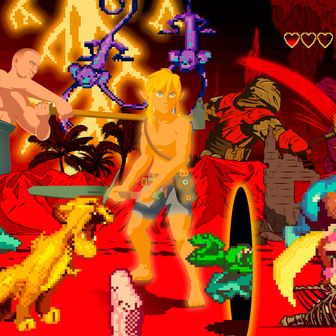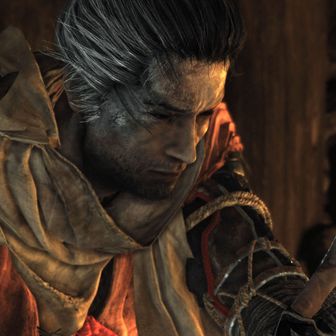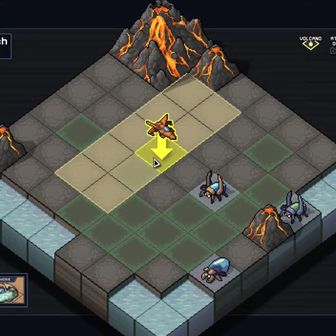
People have strong feelings about Bennett Foddy. The highest-rated positive review of the designer’s 2017 game Getting Over It With Bennett Foddy reads as follows: “almost killed myself 10/10.” There is a 15-minute video with 8 million views on YouTube that begins with superstar streamer Markiplier threatening to punch Foddy in the gut. Foddy says that he recently received an email from someone saying they hoped he stepped on a LEGO.
Such is life when you’re best known for a certain kind of teeth-grinding, controller-smashing video-game difficulty. Foddy’s first game, 2008’s QWOP, is a Ramones-tier debut, perfect in its distillation of its creator’s design philosophy: An athlete stands tense at a track, ready to run 100 meters. Depending on which button you press — options are the title characters Q, W, O, and P — the runner rotates backward, falls on the track, or melts forward, his rear leg flailing up horrifically behind him. Nothing does what you want. QWOP earned a reputation as an impossible game, even appearing on an episode of The Office, because of the way it immediately and hilariously subverts player intent.
“When you’re talking about difficulty in games, it has to be framed in terms of How do people expect this run to go?” Foddy said during a recent call. “And how did it actually go? And are the points of difficulty in the places where I expected them to be?”
QWOP was pretty good for something he designed to procrastinate while working on his Ph.D. in philosophy. Foddy, who is now 44, moved to the New York area in the mid-aughts — following a stint as bassist for the band Cut Copy — to do postdoctoral research, applying his knowledge to the video games he was making on the side. Propelled by QWOP’s success, Foddy developed a handful of successors (GIRP, CLOP) and bailed on the philosophy world to teach video-game design at NYU.
The defining characteristic of his work is that it valorizes difficulty in a way that reframes it — an approach best captured in Getting Over It With Bennett Foddy, which sold more than 3 million copies and was briefly the best-selling game on Steam. Getting Over It’s success was propelled by clips of famous streamers going ballistic as they tried to climb a vast pile of trash with only a hammer and no checkpoints to help when they inevitably fell.
The game is a completely singular experience. Infuriating, yes, but soundtracked by meditative jazz and layered with a game-length monologue from Foddy about the game’s influences and, ultimately, the nature of its challenge. After a particularly rough fall, Foddy chimes in with his Australian accent to comment, “Oof, you just lost a lot of progress.” It’s always clear that this game was designed by one specific person, and the “with Bennett Foddy” part of the title makes more sense as you gradually associate progress with a new set of his musings — some of them supportive, some of them taunting.
Emphasizing his authorship in those ways was important to Foddy. The game was released just a few years after the Gamergate harassment campaign, when, as Foddy says, there was a sense of “oppositionality between players and developers” and some players had adopted a more consumerist stance that saw games as a service provided to players. There was a belief, in other words, that developers should shut up and produce content. Getting Over It rebuked that position in its own way. Many modern blockbuster games feature elaborate progression systems and generous checkpointing to soften the fear of failure, guaranteeing player progress no matter what. But Getting Over It is all about lost progress: One errant hammer swing can send you flailing down the junk heap with hours of effort lost in a single careless moment. Foddy’s voice-over contextualizes all of this as intentional, even “disobedient” of the game — the software refusing to yield to a player’s desires.
Such unfriendly design is not intended to inflate the self-esteem of any players who can conquer it but rather to centralize the beauty of failure, to normalize the feeling of powerlessness. Citing a talk by his NYU colleague and game-design teacher Frank Lantz, Foddy proudly calls Getting Over It “a choke machine,” marveling at its ability to break people down, make them “tilt,” or become so emotional that they begin to make escalating bad decisions. It’s those high-intensity moments that underscore the medium’s capacity for expressiveness.
“That’s the essence of what’s good about games,” Foddy says. “The sense that I’ve become aware of what’s happening in my mind right now. And I’m seeing it reflected through what’s happening on the pixels coming through my hands on the controller, and that’s giving me a little window into what’s going on with me. You can find Zen through an extreme moment of non-Zen.”
In recent years, “git gud” has become a rallying cry for a certain type of gatekeeping gamer who embraces difficulty at all costs and whose particular neurochemical makeup Foddy admits his games appeal to. But Foddy’s own games represent “more of a ‘get bad’ ideology,” he says with a laugh. “I really do think that it’s about telling people to get bad. I want people to feel like I do when I’m playing a difficult game, which is that I’m having a good time despite being really terrible at it.”
It’s still just a game at the end of the day — and if it’s being disobedient, we can respond to its obstacles and obfuscations not with rage or despair but a rueful laugh. And, yes, another try.







